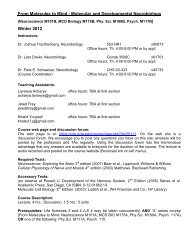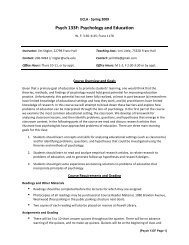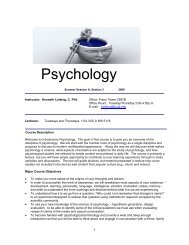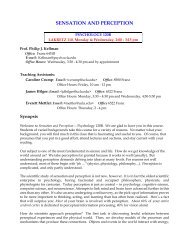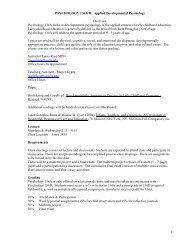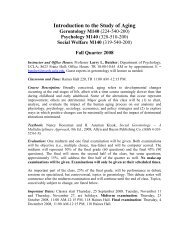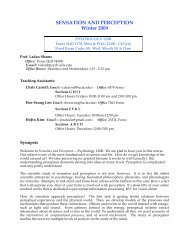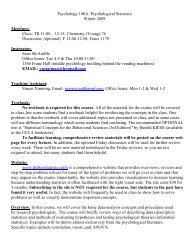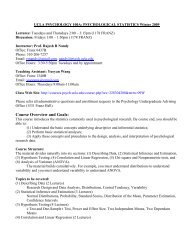Psych 240A Winter 2012 syllabus 5 - Courses in Psychology - UCLA
Psych 240A Winter 2012 syllabus 5 - Courses in Psychology - UCLA
Psych 240A Winter 2012 syllabus 5 - Courses in Psychology - UCLA
Create successful ePaper yourself
Turn your PDF publications into a flip-book with our unique Google optimized e-Paper software.
<strong>Psych</strong>ology <strong>240A</strong>: Language and Cognitive Development<strong>W<strong>in</strong>ter</strong> <strong>2012</strong>; Friday 9 – 11:50; 6461 Franz HallInstructors:Scott Johnsonscott.johnson@ucla.edu310-825-55372291B Franz HallOffice Hours: W 11-12Jim Stiglerstigler@psych.ucla.edu310-206-94942279B Franz HallOffice Hours: Th 10-11This graduate-level sem<strong>in</strong>ar is designed to be an <strong>in</strong>troduction to the broad field of research onlanguage and cognitive development. The goal of the course is to give students the opportunityto explore some of the theories, methods, and f<strong>in</strong>d<strong>in</strong>gs that are prom<strong>in</strong>ent <strong>in</strong> the field today.Course RequirementsBecause this is a work<strong>in</strong>g graduate sem<strong>in</strong>ar, students will be expected to prepare for, andparticipate actively <strong>in</strong>, all class discussions. Weekly preparation <strong>in</strong>cludes read<strong>in</strong>g, writ<strong>in</strong>g, andpeer reviews/evaluations of your classmates writ<strong>in</strong>g.60% of your grade will be based on class participation, weekly writ<strong>in</strong>g assignments,and reviews/evaluations of peer writ<strong>in</strong>g. 40% will be based on a f<strong>in</strong>al paper.Read<strong>in</strong>gs• Students are expected to come to class prepared, all read<strong>in</strong>gs complete, and toparticipate actively <strong>in</strong> discussions.• All read<strong>in</strong>gs are posted on our class website, which can be accessed throughhttp://my.ucla.edu. Some are pdf files than can be directly downloaded; most are l<strong>in</strong>ks tofiles that can only be downloaded on campus.Writ<strong>in</strong>g Assignments• Students are expected to complete a short writ<strong>in</strong>g assignment <strong>in</strong> preparation for eachweek’s class. Writ<strong>in</strong>g assignments will be assigned dur<strong>in</strong>g class and are due bymidnight on the Wednesday before the next class. Writ<strong>in</strong>g assignments should beno more than one page, s<strong>in</strong>gle-spaced.• Writ<strong>in</strong>g assignments must be submitted through turnit<strong>in</strong>. To submit your writ<strong>in</strong>gassignment, log<strong>in</strong> to my.ucla and click the turnit<strong>in</strong> l<strong>in</strong>k under <strong>Psych</strong> <strong>240A</strong>. Do not godirectly to turnit<strong>in</strong>.com as it will not recognize your user id. Do not put your name onyour writ<strong>in</strong>g assignment as it will be reviewed anonymously by your classmates.Peer Reviews of Writ<strong>in</strong>g Assignments• In addition to the weekly writ<strong>in</strong>g assignment, all students are expected to complete fourpeer reviews of their classmates writ<strong>in</strong>g assignments each week. (These will be assignedto you by the turnit<strong>in</strong> PeerMark system.) Peer reviews must be completed onThursday (i.e., between midnight on Wednesday and midnight on Thursday)before the Friday class.• To complete your peer reviews, log<strong>in</strong> to my.ucla on Thursday. Click the turnit<strong>in</strong> l<strong>in</strong>kunder <strong>Psych</strong> <strong>240A</strong>, and you will have a PeerMark assignment ready to complete. Read<strong>Psych</strong> <strong>240A</strong> <strong>2012</strong> – Page 1
F<strong>in</strong>al Papereach of the four writ<strong>in</strong>g assignments, rate their quality, and provide some writtenfeedback to the authors.40% of the grade will be based on a f<strong>in</strong>al paper. The f<strong>in</strong>al paper will be due one week after thef<strong>in</strong>al class, and will likely consist of a brief research proposal, <strong>in</strong>clud<strong>in</strong>g a statement of theproblem, the specific research question, a review of a few relevant studies, and a researchdesign. Paper topics should be discussed with one of the <strong>in</strong>structors and approved <strong>in</strong> advance.Our philosophy is that the paper you write should, <strong>in</strong> some way, move you along your careerpath. Thus, we will be flexible on the type of paper you write. Please talk with one of the<strong>in</strong>structors as you develop your paper topic.Schedule of Classes1/13 Introduction to the Course (class starts at 10:15 this day only)1/20 Foundations of Development <strong>in</strong> Infancy: Methods and Theory• Asl<strong>in</strong>, R. N. (2007). What’s <strong>in</strong> a look? Developmental Science, 10, 48-53.• Johnson, S. P. (2010). How <strong>in</strong>fants learn about the visual world. Cognitive Science,34, 1158-1184.• Spelke, E. S. & K<strong>in</strong>zler, K. D. (2007). Core knowledge. Developmental Science,10, 89–96.• Spencer, J. P., Blumberg, M. S., McMurray, B., Rob<strong>in</strong>son, S. R., Samuelson, L.K., and Tombl<strong>in</strong>, J. B. (2009). Short arms and talk<strong>in</strong>g eggs: Why we should nolonger abide the nativist–empiricist debate. Child Development Perspectives, 3, 79-87.1/27 Perceptual Development <strong>in</strong> Infancy• Bhatt, R. S., & Qu<strong>in</strong>n, P. C. (2011). How does learn<strong>in</strong>g impact development <strong>in</strong><strong>in</strong>fancy? The case of perceptual organization. Infancy, 16, 2-38.• Saffran, J. R., Asl<strong>in</strong>, R. N., & Newport, E. L. (1996). Statistical learn<strong>in</strong>g by 8-monthold<strong>in</strong>fants. Science, 274, 1926-1928.• Kirkham, N. Z., Slemmer, J. A., & Johnson, S. P. (2002). Visual statistical learn<strong>in</strong>g<strong>in</strong> <strong>in</strong>fancy: Evidence for a doma<strong>in</strong> general learn<strong>in</strong>g mechanism. Cognition, 83, B35-B42.• Werker, J. F., & Tees, R. C. (2002). Cross-language speech perception: Evidencefor perceptual reorganization dur<strong>in</strong>g the first year of life. Infant Behavior &Development, 25, 121-133.2/3 Social Development <strong>in</strong> Infancy• Haml<strong>in</strong>, J. K., Wynn, K., & Bloom, P. (2007). Social evaluation by preverbal <strong>in</strong>fants.Nature, 450, 557-560.• Farroni, T., Csibra, G., Simion, F., & Johnson, M. H. (2002). Eye contact detection<strong>in</strong> humans from birth. Proceed<strong>in</strong>gs of the National Academy of Sciences (USA), 99,9602-9605.• Frank, M. C., Vul, E., & Johnson, S. P. (2009). Development of <strong>in</strong>fants’ attention tofaces dur<strong>in</strong>g the first year. Cognition, 110, 160-170.• Kuhl, P. K. (2004). Early language acquisition: Crack<strong>in</strong>g the speech code. Nature<strong>Psych</strong> <strong>240A</strong> <strong>2012</strong> – Page 2
Reviews Neuroscience, 5, 831-843.2/10 No Class Today!2/17 Cognitive Development <strong>in</strong> Infancy• Marcus, G. F., Vijayan, S., Bandi Rao, S., & Vishton, P. M. (1999). Rule learn<strong>in</strong>g <strong>in</strong>7-month-old <strong>in</strong>fants. Science, 283, 77-80.• Marcus, G. F., Fernandes, K. J., & Johnson, S. P. (2007). Infant rule learn<strong>in</strong>gfacilitated by speech. <strong>Psych</strong>ological Science, 18, 387-391.• Baillargeon, R. (1987). Object permanence <strong>in</strong> 3.5- and 4.5-month-old <strong>in</strong>fants.Developmental <strong>Psych</strong>ology, 23, 655-664.• Johnson, S. P., Amso, D., & Slemmer, J. A. (2003). Development of objectconcepts <strong>in</strong> <strong>in</strong>fancy: Evidence for early learn<strong>in</strong>g <strong>in</strong> an eye track<strong>in</strong>g paradigm.Proceed<strong>in</strong>gs of the National Academy of Sciences (USA), 100, 10568-10573.2/24 Language, Th<strong>in</strong>k<strong>in</strong>g, and Learn<strong>in</strong>gGUEST: Prof. Susan Gold<strong>in</strong>-Meadow, University of Chicago• Gold<strong>in</strong>-Meadow, S. & Beilock, S. (2010). Action’s <strong>in</strong>fluence on thought: The case ofgesture. Perspectives on <strong>Psych</strong>ological Science, 5, 664-674.• Gold<strong>in</strong>-Meadow, S. & Wagner, S. M. (2005). How our hands help us learn. Trends <strong>in</strong>Cognitive Sciences, 9, 234-241.• Gold<strong>in</strong>-Meadow, S., Cook, S.W. & Mitchell, Z.A. (2009). Gestur<strong>in</strong>g gives childrennew ideas about math. <strong>Psych</strong>ological Science, 20, 267-272.• Rowe, M.L. & Gold<strong>in</strong>-Meadow, S. (2009). Differences <strong>in</strong> early gesture expla<strong>in</strong> SESdisparities <strong>in</strong> child vocabulary size at school entry. Science, 323, 951–953.3/2 Development of Language and ConceptsGUEST: Prof. Cather<strong>in</strong>e Sandhofer, <strong>UCLA</strong>• Bloom, P. (2001). Precis of "How children learn the mean<strong>in</strong>gs of words". Behavioraland Bra<strong>in</strong> Sciences, 24, 1095-1131 (<strong>in</strong>clud<strong>in</strong>g the commentaries)• Kowalski, K., & Zimiles, H. (2006). The relation between children’s conceptualfunction<strong>in</strong>g with color and color term acquisition. Journal of Experimental Child<strong>Psych</strong>ology, 94, 301–321.• Mix, K. S., & Sandhofer, C. M. & Baroody, A. (2005). Number words and numberconcepts: The <strong>in</strong>terplay of verbal and nonverbal processes <strong>in</strong> early quantitativedevelopment. In R.V. Kail (Ed.) Advances <strong>in</strong> Child Development and Behavior, 33,(pp 305-346). New York: Academic Press.• Hespos, S. J., & Spelke, E. S. (2004). Conceptual precursors to language. Nature,430, 453-4563/9 Perceptual Learn<strong>in</strong>g and the Development of ExpertiseGUEST: Prof. Phil Kellman, <strong>UCLA</strong>• Kellman, P. J. & Garrigan, P. (2009). Perceptual learn<strong>in</strong>g and human expertise.Physics of Life Reviews, 6, 53-84. (OK to skim sections 4 and 5.)• Kellman, P. J., Massey, C., & Son, J. Y. (2009). Perceptual learn<strong>in</strong>g modules <strong>in</strong>mathematics: Enhanc<strong>in</strong>g students’ pattern recognition, structure abstraction, andfluency. Topics <strong>in</strong> Cognitive Science, 1-21.<strong>Psych</strong> <strong>240A</strong> <strong>2012</strong> – Page 3
3/16 Mathematics Teach<strong>in</strong>g and Learn<strong>in</strong>g• Erlwanger, S. H. (1973). Benny's conception of rules and answers <strong>in</strong> IPImathematics. Journal of Children's Mathematical Behavior, Autumn, 7-26.• Kamii, C. & Clark, F.B. (1995). Equivalent fractions: Their difficulty and educationalimplications. Journal of Mathematical Behavior, 14, 365-378.• Hiebert, J. (1984). Children's mathematics learn<strong>in</strong>g: The struggle to l<strong>in</strong>k form andunderstand<strong>in</strong>g. Elementary School Journal, Vol. 84, No. 5, 496-513.• Sophian, C. (2007). Reth<strong>in</strong>k<strong>in</strong>g the start<strong>in</strong>g po<strong>in</strong>t for mathematics learn<strong>in</strong>g. In O. N.Saracho & B. Spodek (Eds.), Contemporary perspectives on mathematics <strong>in</strong> earlychildhood education. Information Age Publish<strong>in</strong>g.• Stigler, J. W., Fernandez, C., and Yoshida, M. (1996). Cultures of mathematics<strong>in</strong>struction <strong>in</strong> Japanese and American elementary classrooms. In T. Rohlen and G.Le Tendre (Eds.), Teach<strong>in</strong>g and learn<strong>in</strong>g <strong>in</strong> Japan. New York: Cambridge UniversityPress. Pp. 213-247.<strong>Psych</strong> <strong>240A</strong> <strong>2012</strong> – Page 4



